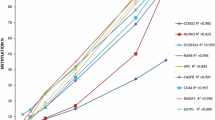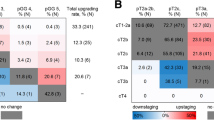Abstract
Objective
The risk of local recurrence after radical prostatectomy (RP) is considerably dependent on local tumor stage. To improve local staging, the aim of this study was to assess the feasibility of quantitative methylation-specific PCR (Q-MSP) for the identification of promoter hypermethylation of the detoxifying glutathione-S-transferase P1 gene (GSTP1) to detect occult prostate cancer (PCa) cells in the prostatic fossa after RP.
Methods
A total of 39 consecutive patients with clinically organ-confined PCa underwent RP. After gland excision, biopsies were obtained from eight defined areas of the prostatic fossa and bisected for both histopathological and molecular analyses. Results were related to clinicopathological data including tumor stage, Gleason score, prostate-specific antigen (PSA), and biochemical recurrence.
Results
Of 39 patients, 11 with PCa had at least one positive molecular margin status indicated by GSTP1 methylation. These included 5 of 17 (29.4%) with organ-confined and 6 of 22 (27.3%) with advanced (≥pT3 and/or pN+) PCa. GSTP1 methylation in surgical margins strongly correlated with histopathological R-status (P = 0.022) and preoperative PSA (P = 0.01) whereas no association with tumor stage (pT2 vs pT3), grade (Gleason score <7 vs ≥7), and lymph node status was found. No patient experienced biochemical relapse.
Conclusions
GSTP1 hypermethylation detected by Q-MSP in prostatic fossa biopsies after RP is well suited for the detection of occult tumor cells in surgical margins. However, the limited number of patients and the short-term follow-up does not allow definite conclusions on the prognostic value of GSTP1 in surgical margins.

Similar content being viewed by others
References
Kattan MW, Eastham JA, Stapleton AM, Wheeler TM, Scardino PT (1998) A preoperative nomogram for disease recurrence following radical prostatectomy for prostate cancer. J Natl Cancer Inst 90:766–771
Swindle P, Eastham JA, Ohori M, Kattan MW, Wheeler T, Maru N, Slawin K, Scardino PT (2008) Do margins matter? The prognostic significance of positive surgical margins in radical prostatectomy specimens. J Urol 179:47–51
Han M, Partin AW, Zahurak M, Piantadosi S, Epstein JI, Walsh PC (2003) Biochemical (prostate specific antigen) recurrence probability following radical prostatectomy for clinical localized prostate cancer. J Urol 169:517–523
Bolla M, Poppel H, Collette L, Cangh P, Vekemans K, Da Pozzo L, Reijke TM, Verbaeys A, Bosset JF, Velthoven R, Maréchal JM, Scalliet P, Haustermans K, Piérart M (2005) Postoperative radiotherapy after radical prostatectomy: a randomised controlled trail (EORTC trail 22911). Lancet 366:572–578
Nelson WG, De Marzo AM, Isaacs WB (2003) Prostate cancer. N Engl J Med 349:366–381
Goessl C, Müller M, Heicappell R, Krause H, Miller K (2001) DNA-based detection of prostate cancer in blood, urine, and ejaculates. Ann NY Acad Sci 945:51–58
Köllermann J, Müller M, Goessl C, Krause H, Helpap B, Pantel K, Miller K (2003) Methylation-specific PCR for DNA-based detection of occult tumor cells in lymph nodes of prostate cancer patients. Eur Urol 44:533–538
Bastian PJ, Palapattu GS, Lin X, Yegnasubramanian S, Mangold LA, Trock B, Eisenberger MA, Partin AW, Nelson WG (2005) Preoperative serum DNA GSTP1 CpG island hypermethylation and the risk of early prostate-specific antigen recurrence following radical prostatectomy. Clin Cancer Res 11(11)
Nakayama M, Gonzalgo ML, Yegnasubramanian S, Lin X, De Marzo AM, Nelson WG (2004) GSTP1 CpG island hypermethylation as a molecular biomarker for prostate cancer. J Cell Biochem 91:540–552
Hanson JA, Gillespie JW, Grover A, Tangrea MA, Chuaqui RF, Emmert-Buck MR, Tangrea JA, Libutti SK, Linehan WM, Woodson KG (2006) Gene promoter methylation in prostate tumor-associated stromal cells. J Natl Cancer Inst 98(4):255–261
McNeal JE (1969) Origin and development of carcinoma of the prostate. Cancer 23:24
Chen ME, Johnston DA, Tang K, Babaian RJ, Troncoso P (2000) Detailed mapping of prostate carcinoma foci: biopsy strategy implications. Cancer 89(8):1800–1809
Jeronimo C, Usadel H, Henrique R, Oliveira J, Lopes C, Nelson WG, Sidransky D (2001) Quantitation of GSTP1 methylation in non-neoplastic prostatic tissue and organ-confined prostate adenocarcinoma. J Natl Cancer Inst 93:1747–1752
Straub B, Müller M, Krause H, Goessl C, Schrader M, Heicappell R, Miller K (2001) Reverse transcriptase-polymerase chain reaction for prostate-specific antigen in the molecular staging of pelvic surgical margins after radical prostatectomy. Urol 57:1006–1011
Theodorescu D, Frierson HF, Sikes RA (1999) Molecular determination of surgical margins using fossa biopsies at radical prostatectomy. J Urol 161:1442–1448
Nakayama M, Bennett CJ, Hicks JL, Epstein JI, Platz EA, Nelson WG, De Marzo AM (2003) Hypermethylation of the human glutathione S-transferase-pi gene (GSTP1) CpG island is present in a subset of proliferative inflammatory atrophy lesions but not in normal or hyperplasitc epithelium of the prostate: a detailed study using laser-capture microdissection. Am J Pathol 163:923–933
Bastian PJ, Yegnasubramanian S, Palapattu GS, Rogers CG, Lin X, De Marzo AM, Nelson WG (2004) Molecular biomarker in prostate cancer: the role of CpG island hypermethylation. Eur Urol 46:698–708
Harden SV, Sanderson H, Goodman SN, Partin AA, Walsh PC, Epstein JI, Sidransky D (2003) Quantitative GSTP1 methylation and the detection of prostate adenocarcinoma in sextant biopsies. J Natl Cancer Inst 95:1634–1637
Henrique R, Jeronimo C (2004) Molecular detection of prostate cancer: a role for GSTP1 hypermethylation. Eur Urol 46:660–669
Bastian PJ, Ellinger J, Heukamp LC, Kahl P, Müller SC, von Rücker A (2007) Prognostic value of CpG island hypermethylation at PTGS2, RAR-beta, EDNRB and other gene loci in patients undergoing radical prostatectomy. Eur Urol 51:665–674
Acknowledgments
The authors are very grateful to the skillful technical assistance of Mrs. Waltraud Jekabsons.
Conflict of interest
The authors declare that they have no conflict of interest.
Author information
Authors and Affiliations
Corresponding author
Rights and permissions
About this article
Cite this article
Jentzmik, F., Krause, H., Reichelt, U. et al. GSTP1 CpG island hypermethylation for DNA-based detection of occult tumor cells in surgical margins after radical prostatectomy. World J Urol 30, 541–546 (2012). https://doi.org/10.1007/s00345-011-0764-2
Received:
Accepted:
Published:
Issue Date:
DOI: https://doi.org/10.1007/s00345-011-0764-2




